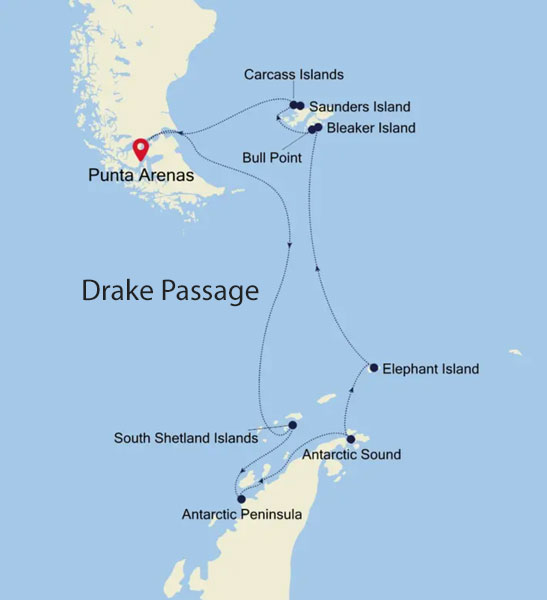
Antarctica
December 19, 2021 to January 6, 2022
Mike and Judy Henderson
I'm going to leave this map at the front of the web page so you can visualize where we are.

++++++++++++++++++++++++++++++++++++++++++++++++
12/31/2021 (Friday, New Year's eve) Location at 6am, 61˚11'S, 54˚36'W, 1˚C, low clouds and some blue sky, sea has a slight swell. Just off Cape Valentine of Elephant Island. I did the research for the following description of Shackleton's Expedition before we left home. I would not have time on the cruise to do it all.
We arrive at Elephant Island today. Elephant Island's claim to fame is that it was where the members of the Imperial Trans-Antarctic Expedition, led by Ernest Shackleton, (often called the Shackleton, or Endurance, Expedition) arrived after spending 15 months trapped on the ice in the Weddell Sea (from January 19, 1915 to April 9, 1916). The ice covering the Weddell sea rotates in a clockwise direction so the expedition party was carried generally northward on the ice pack. Below are two maps showing where they drifted on the ice. The expedition was part of what's called today, the Heroic Age of Antarctic Exploration. [Added note: Shackleton was 40 years old when the expedition started and 42 when it concluded.]
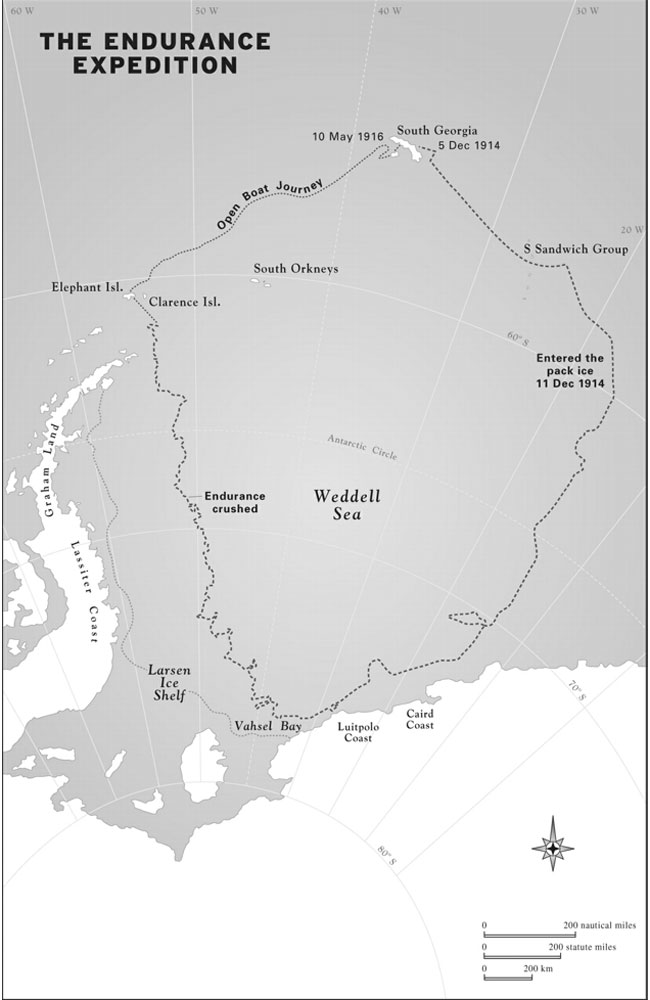
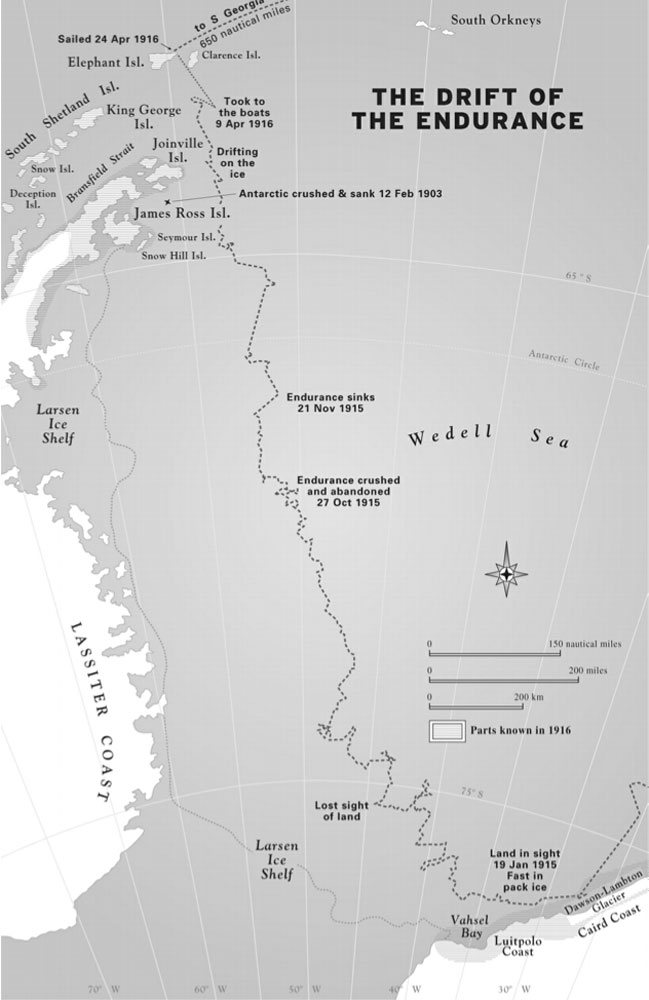
They experienced tremendous hardship during that time, but managed to kill penguins and seals for food and to melt snow and ice for water. [Note: It was pointed out that you cannot maintain hydration by eating snow - your body cannot produce enough heat to melt sufficient snow.] They had originally planned to do an overland trek across Antarctica, so they had equipment and supplies to survive in those conditions. Initially, the Endurance was just trapped in the ice - it was a long time before it was crushed and sunk - so they had lots of time to offload the most important supplies.
Here's a picture of the group. There were 28 men on the expedition. I count 27 men in this picture. The photographer, Hurley, is not in the picture.
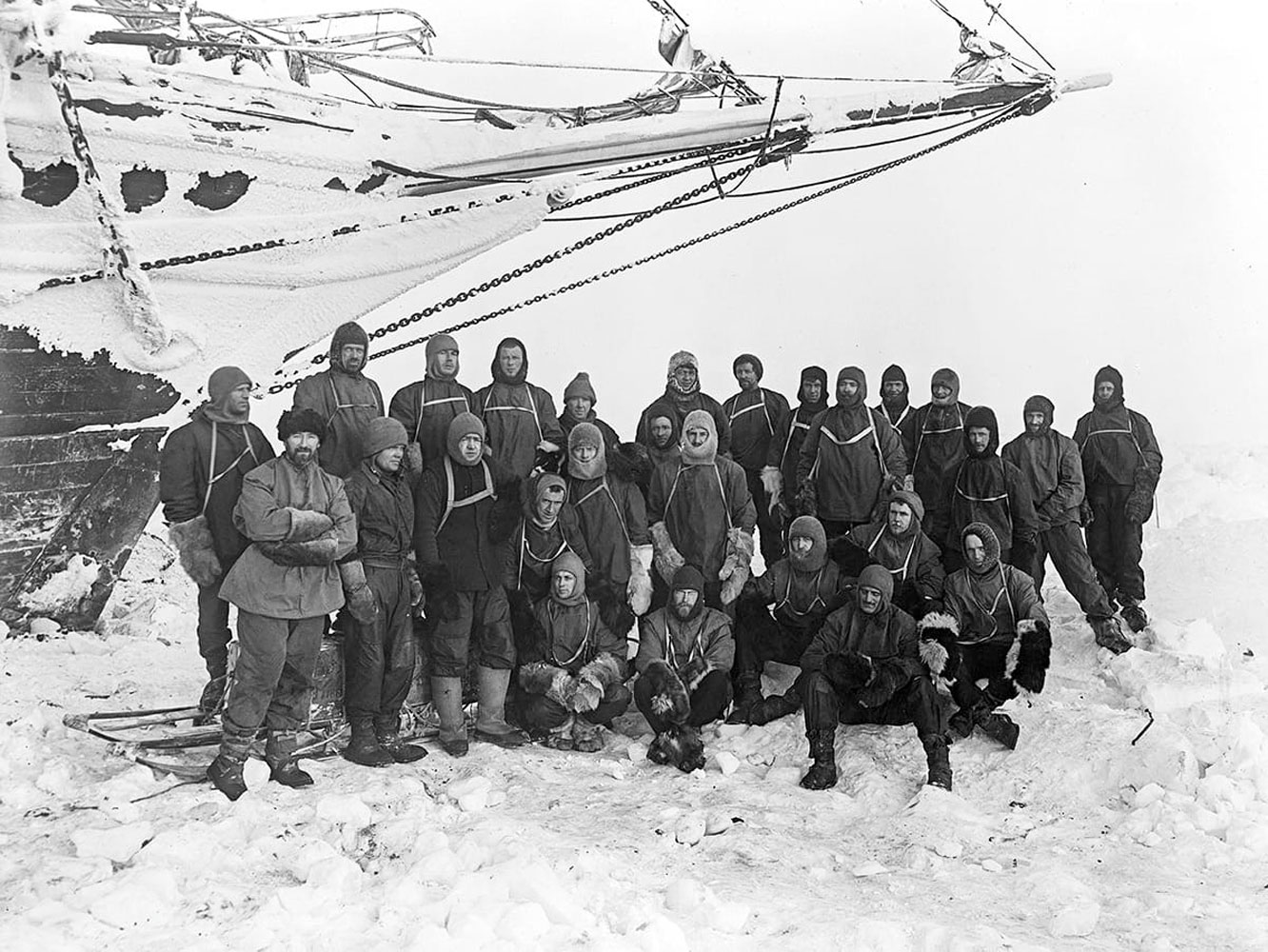
After taking to their boats on April 9, 1916, they initially landed on Elephant Island at Cape Valentine on April 15, 1916, but Cape Valentine was not adequately protected from rising tides and storms, so they moved to a place they called "Cape Wild", named after Frank Wild, the second-in-command of the expedition. The name was changed to "Point Wild" later to avoid confusion with Cape Wild on Antarctica.
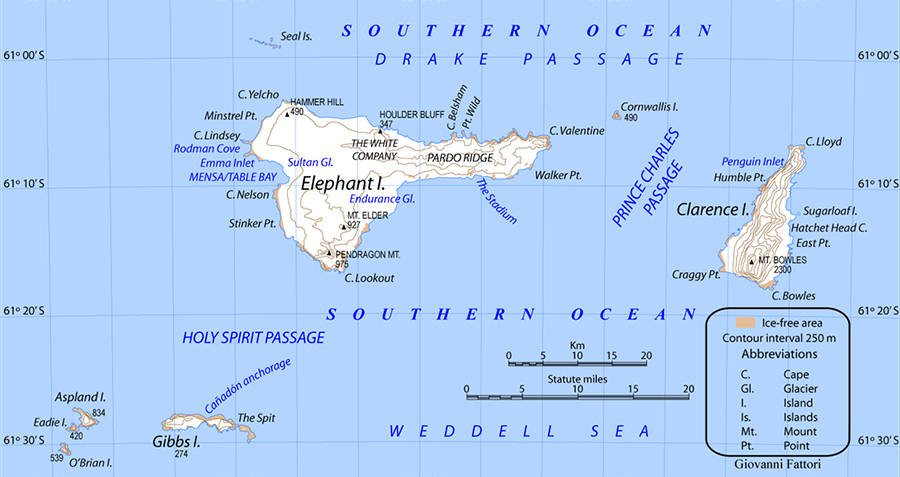
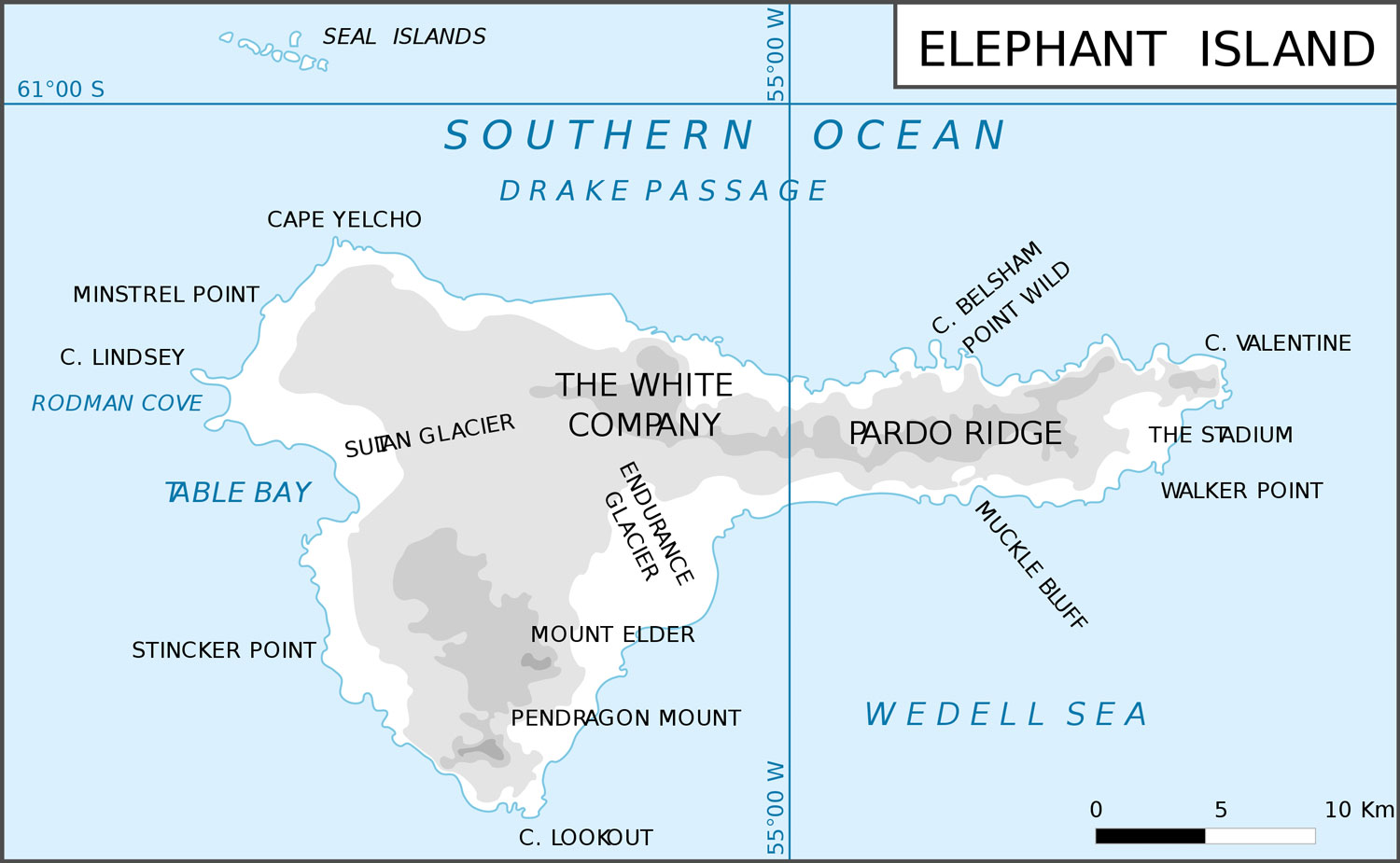
After resting, they prepared one of their boats, the James Caird, in which Shackleton, with Frank Worsley (captain of the Endurance), Tom Crean (second officer), Harry McNeish (carpenter), Timothy McCarthy (able seaman), and John Vincent (able seaman), would attempt to sail to the Stromness whaling station at South Georgia Island. It was the nearest place they could get to where they could find help. The strong eastward current and winds in the Drake Passage would prevent them from making Tierra del Fuego or the Falkland Islands. Twenty-two men were left at Point Wild with the knowledge that if the boat didn't make it, they could die on the island. They had a backup plan to attempt to sail to Deception Island where whalers occasionally called, but their two remaining boats were in poor condition and ill-suited to that journey.
Here's a picture of the men left at Point Wild. There are only 20 men in the picture. One of the missing men was the photographer, Frank Hurley. The other missing man was Perce Blackboro, who was disabled by frozen toes which later had to be amputated. Six men departed in the James Caird, which accounts for all 28 men on the expedition.
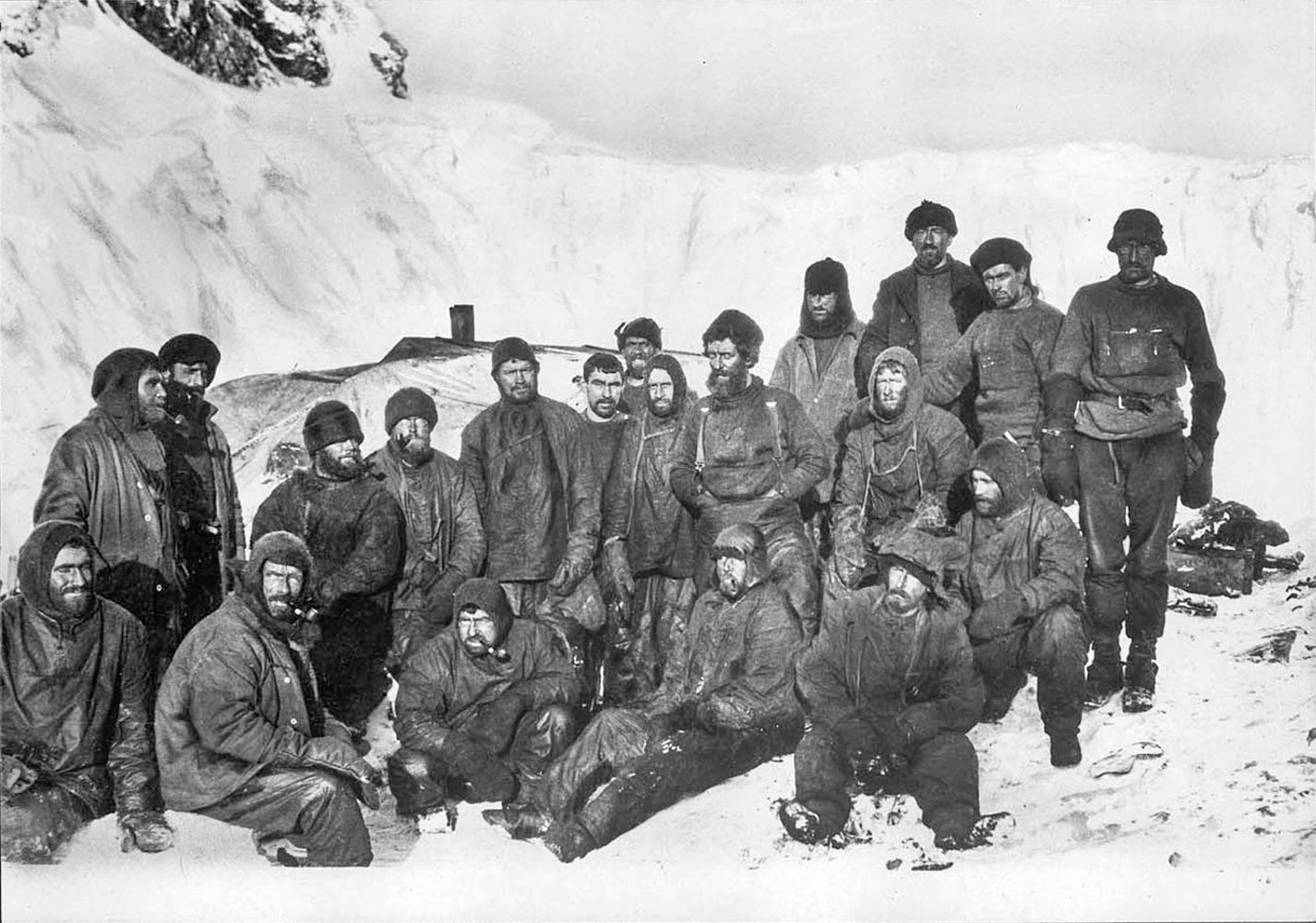
Here's a picture of their departure from Elephant Island on April 24, 1916. The following three pictures are of the departure of the six crewmen in the James Caird (photos by Frank Hurley).
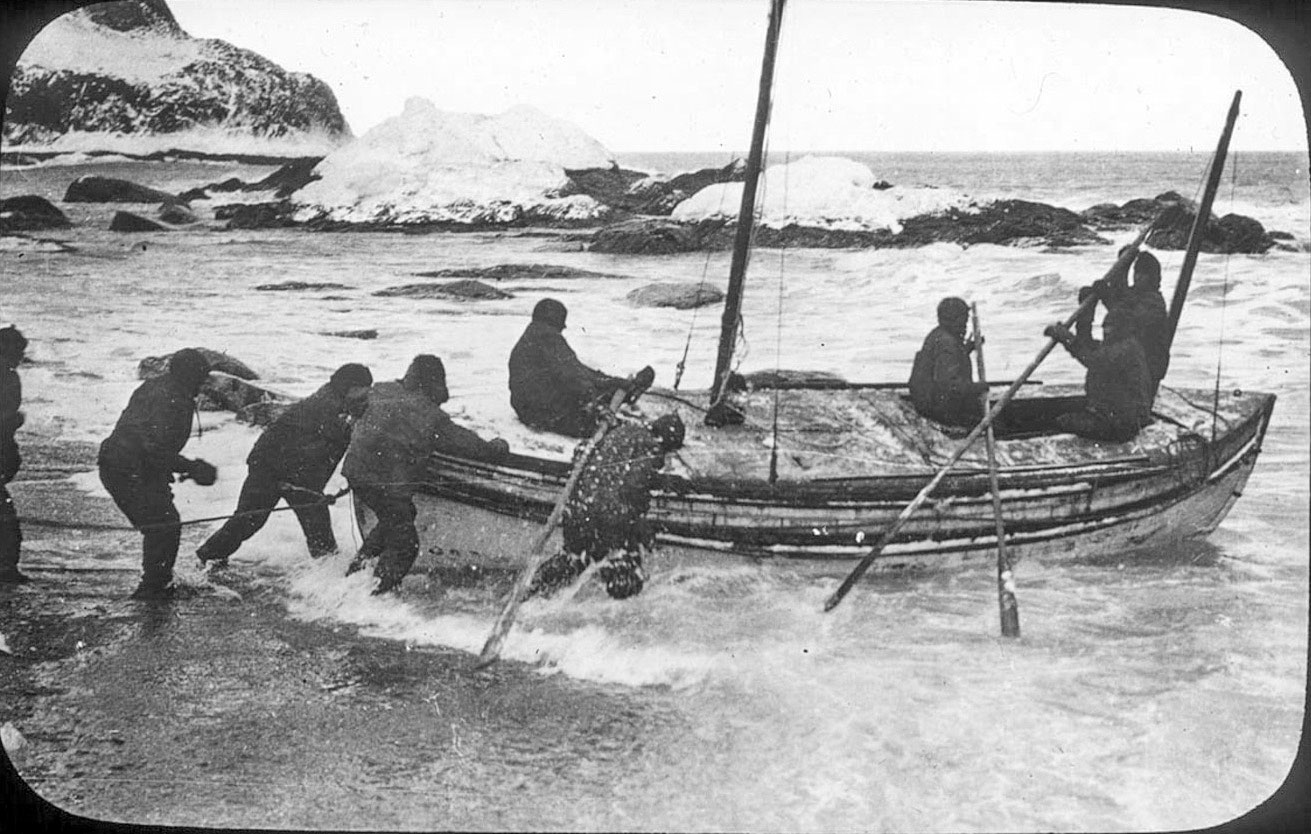
James Caird departing.
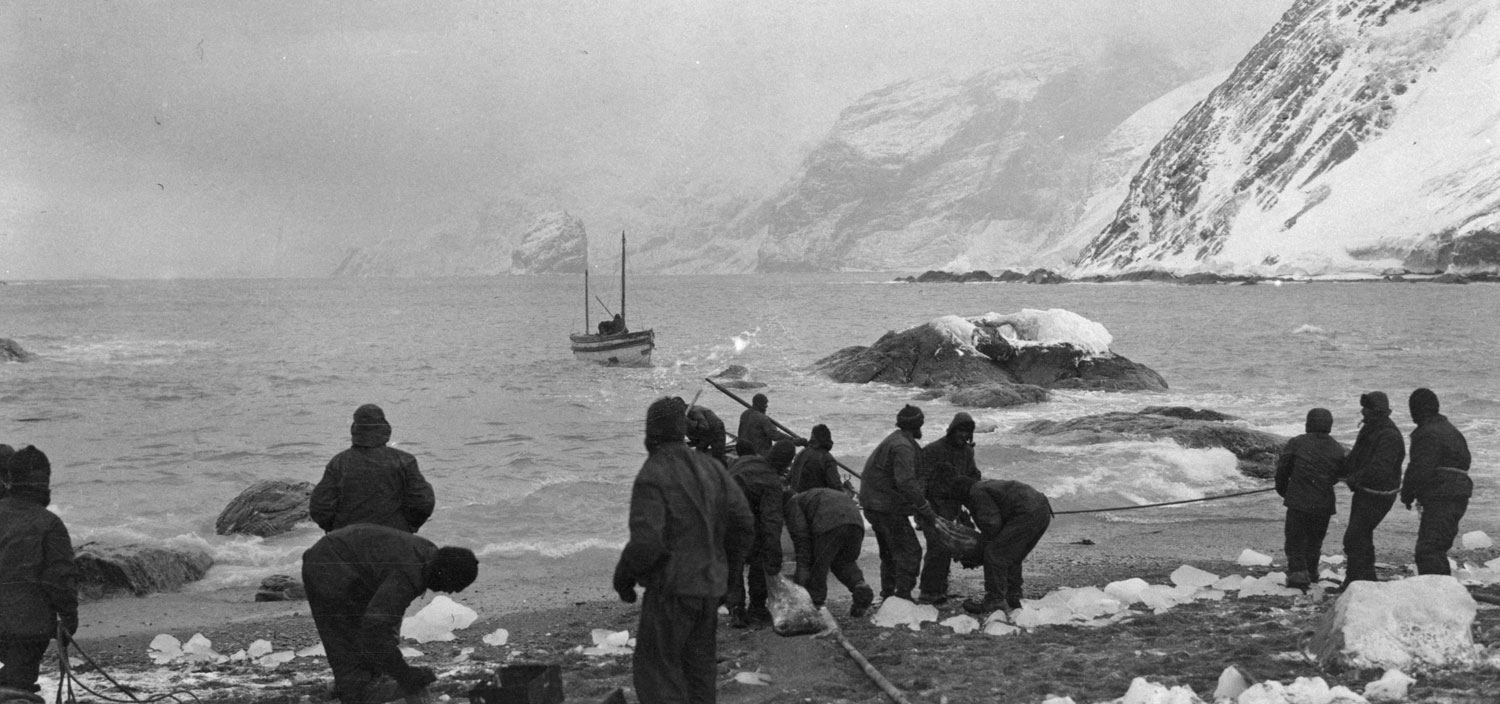
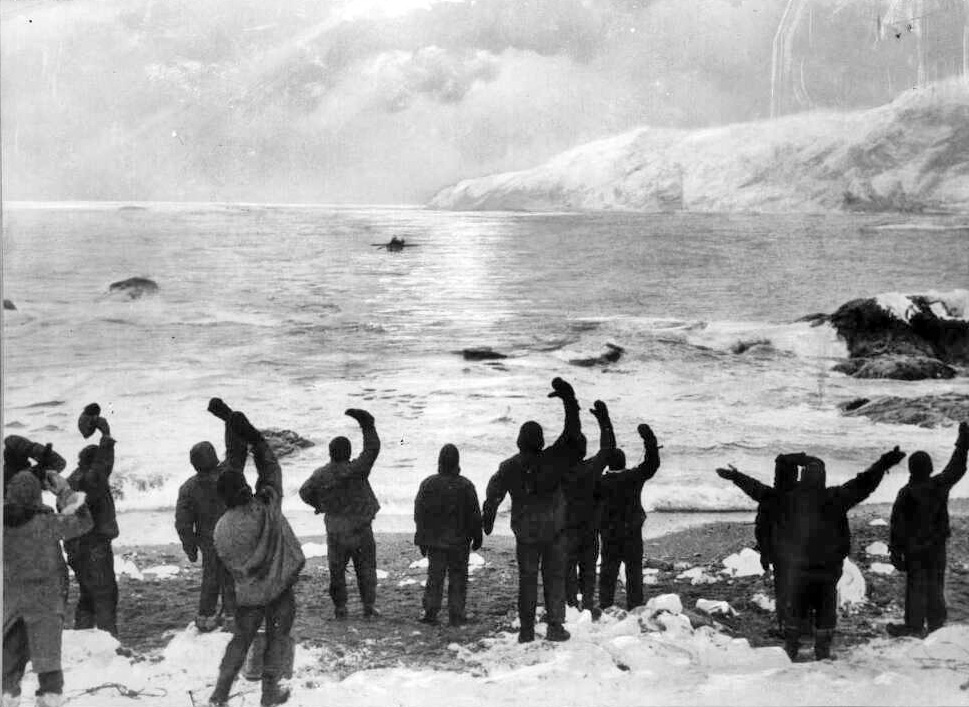
The journey was 780 miles in an open boat, to find a small island in the South Atlantic - but Shackleton and his crew made it, arriving at the uninhabited area of King Haakon Bay in South Georgia on May 10, 1916. (I encourage you to read the account of their voyage here. It's pretty amazing.) Their ordeal was not over, however, and Shackleton, with Worsley and Crean, set off on May 18, 1916 to cross the mountains of the island of South Georgia on foot, to reach the Stromness Whaling Station. They arrived at Stromness on May 20, 1916, 36 hours after departing their landing area. They were ragged, dirty, starving and exhausted, and they were first spotted by children who ran away in fright. The island of South Georgia had never been crossed before and was not crossed again until 1955. This is the route the group took.
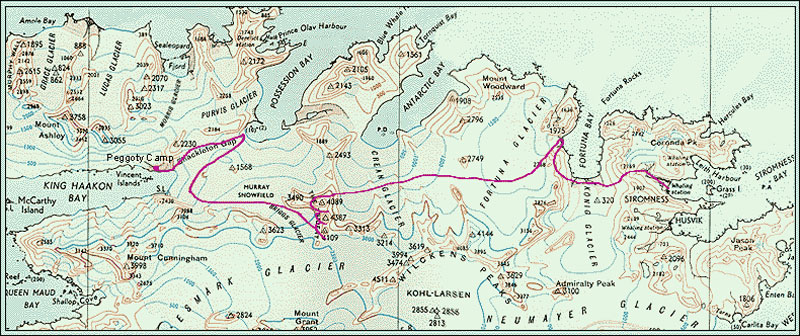
Shackleton left Stromness within 72 hours (May 23, 1916) in the ship Southern Sky, to rescue his men, but was turned back by ice - see here and here. He made three more attempts to rescue the men, two of which failed due to weather, ice and/or mechanical problems. But on August 30, 1916, slightly more than four months after leaving the men on Elephant Island on April 24, 1916, Shackleton returned on the Chilean sea-going tug, the Yelcho, captained by Luis Alberto Pardo Villalón. All of the twenty-two men were alive, although Perce Blackboro had suffered frostbite on his toes and had developed gangrene. Drs. Alexander Macklin and James McIlroy successfully amputated Blackboro's toes on the island (they used the last of the chloroform they had).
Here's a picture of the arrival of the first boat from the Yelcho to the island. The crew was taken off in two boatloads and taken to Punta Arenas. Not a single crew member had been lost.
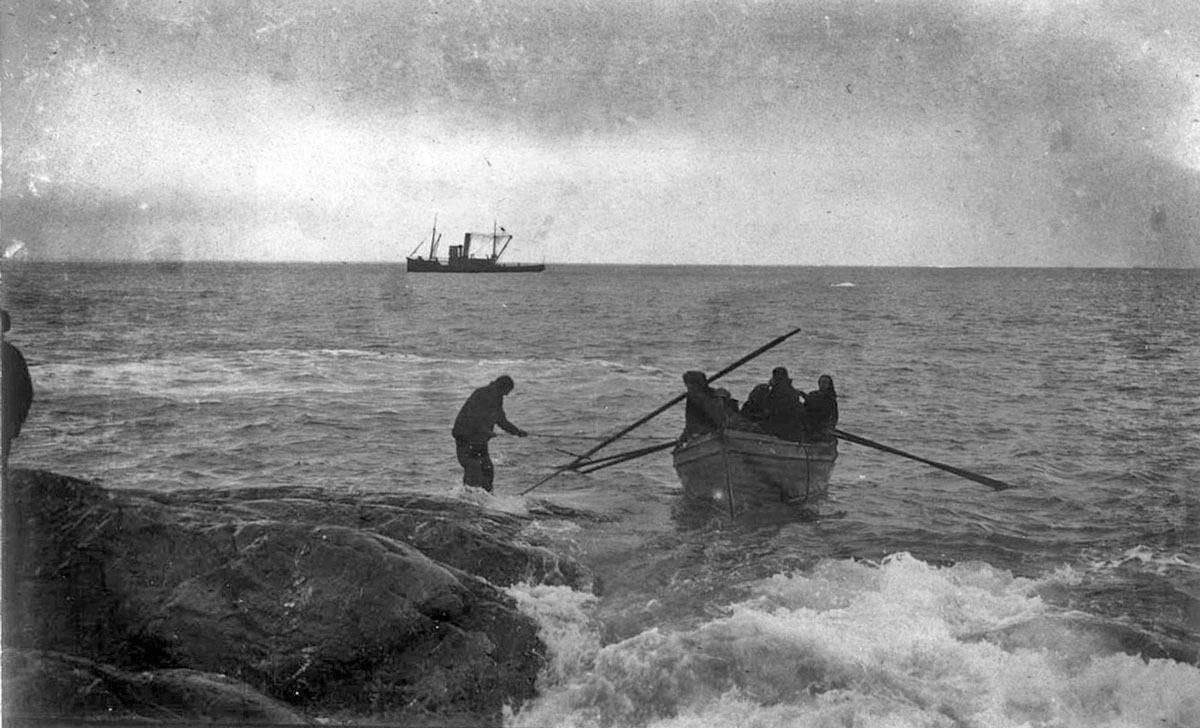
Point Wild was barren and exposed. The crew suffered during the winter of 1916. Here's a picture of the point, taken recently. You can see how exposed it was to the elements.
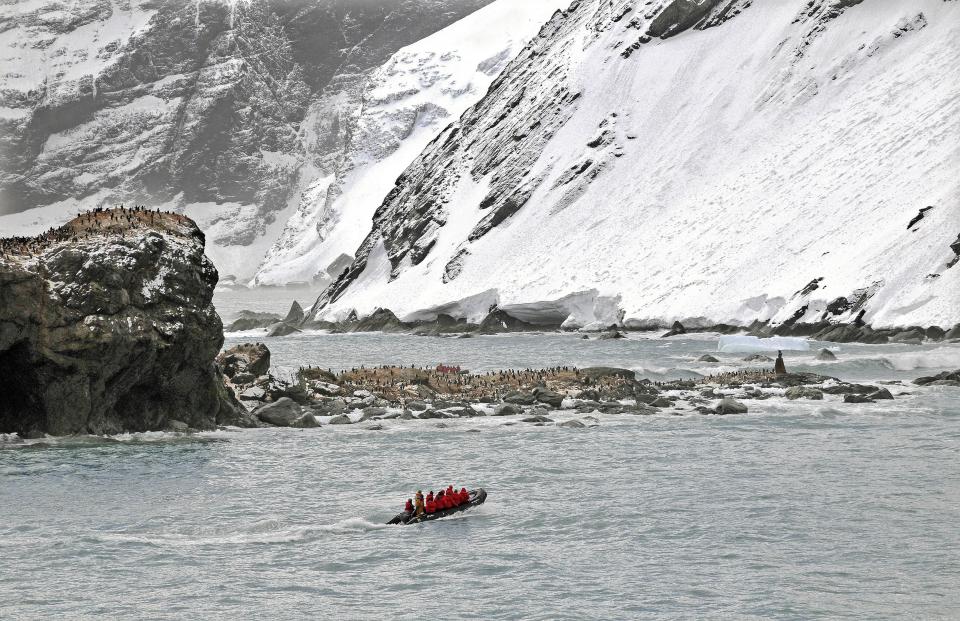
In 1987 Chile erected a monument at the point with a bust of the Yelcho's captain, Luis Alberto Pardo Villalón. While he and his ship saved the men, his contribution was very small compared to Shackleton's, but he was Chilean and Shackleton wasn't.
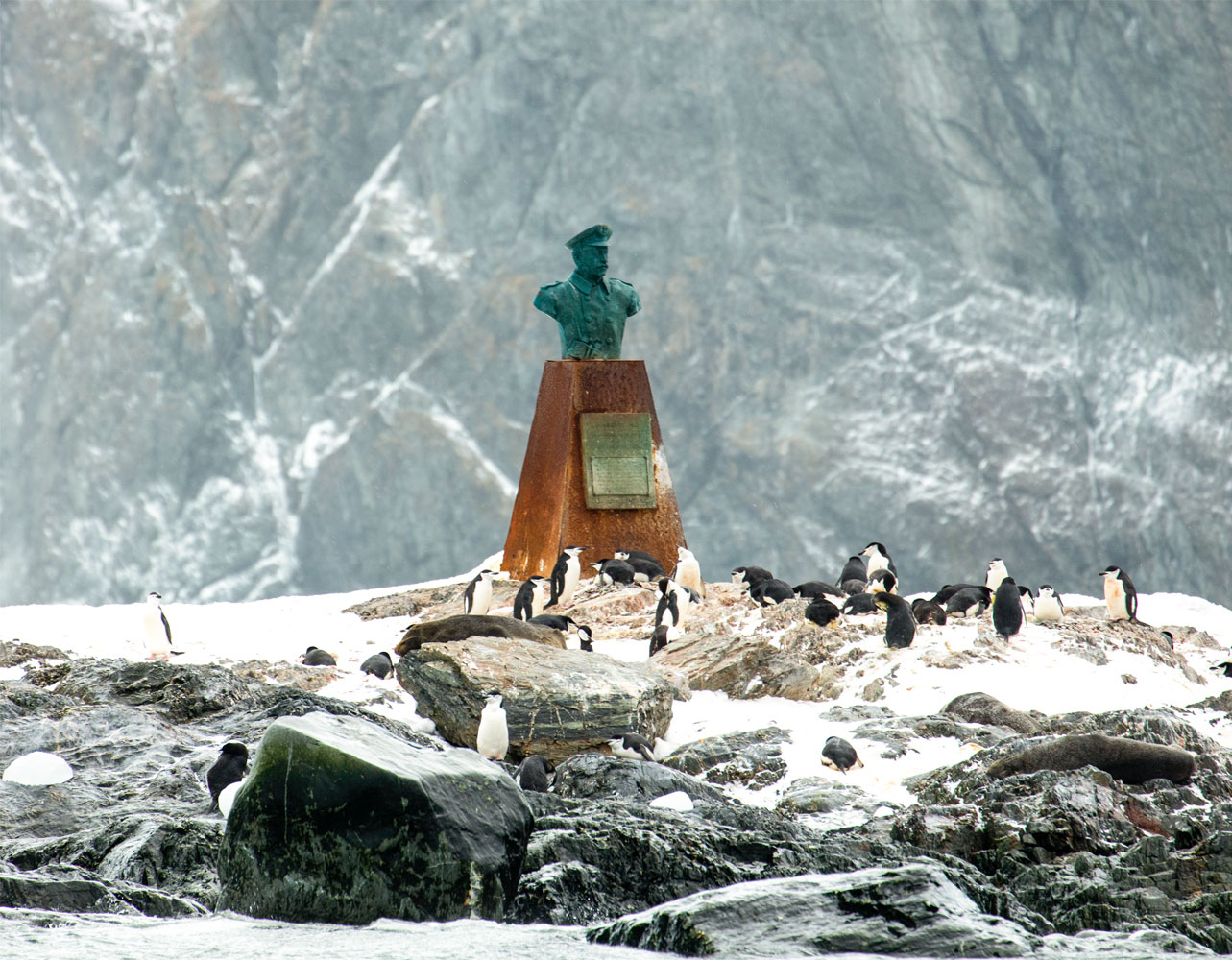
The expedition was well documented - Shackleton had included a professional photographer, Frank Hurley, on the voyage and Hurley produced many photographs, including of their time on the ice and at Point Wild. His photos are held by the Royal Geographic Society and can be seen here, here, here, and here, and in book form here. I highly encourage you to view the pictures - they are amazing, especially for the time. You can see some information about the equipment Hurley had here and about Hurley here. Over a hundred glass negatives, and his professional cameras, had to be left on the ice, because of weight, when they took to the boats, headed for Elephant Island. The pictures Hurley took on Elephant Island were with a basic, non-professional camera and the images are not as good as his earlier ones.
Here's perhaps the most famous of Hurley's pictures of the Expedition - a picture of the Endurance during the Antarctic night. Hurley set up his camera, locked the shutter open, and then went around the ship, outside the camera view, firing off flares. I believe he used 20 flares to make this picture.
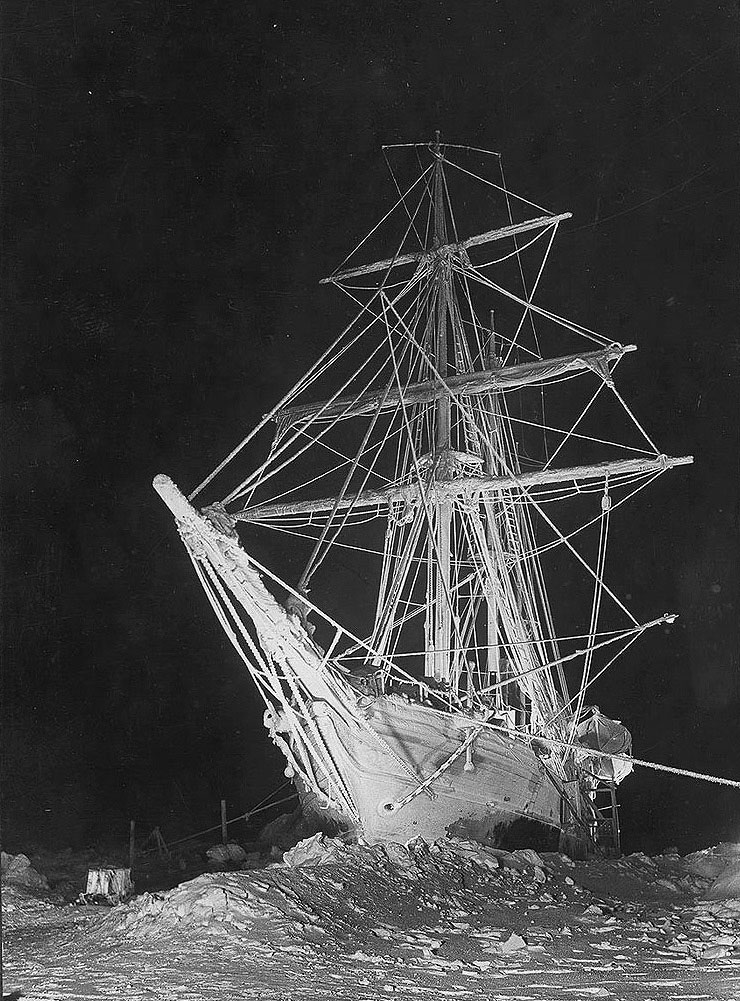
[Here's an entry from Hurley's diary about this picture:
"During the night take flashlight of ship beset by pressure. This necessitated
some 20 flashes, one behind each
salient pressure hummock, no less than 10
flashes being required to satisfactorily illuminate the ship herself.
Half
blinded after the successive flashes, I lost my bearings amidst hummocks,
bumping shins against projecting
ice points & stumbling into deep snow drifts."
- Frank Hurley, diary 27th August 1915.]
If you're interested in learning more, the best book about the expedition is "Endurance: Shackleton's Incredible Voyage" by Alfred Lansing. For a more personal account, you can read "South: The Story of Shackleton's 1914-1917 Expedition" by Shackleton. It's free in Kindle format. If you'd like the short version, click here (several web pages long). Many of the men kept diaries, and they were saved with the men. They were an invaluable source for those who wrote the story of the expedition.
Added note: The Imperial Trans-Antarctica Expedition consisted of two parts. The Endurance on one side of Antarctica and the Aurora on the other side. The crew of the Aurora was charged with laying in supply caches for Shackleton's party to use after they crossed the south pole. They endured circumstances as least as bad as Shackleton and lost three members of their party. The survivors were rescued by Shackleton on January 10, 1917 - but that's another story (the book referenced in this link is not an easy read. The author just put in too much detail about organizing the voyage, provisioning, and details of each crew member.)
Here's a map which shows both sides of the expedition (unfortunately, in French, but you should be able to figure out the legend). Shackleton and the Endurance (ship) are shown at the top of the picture and the Aurora expedition is shown at the lower part of the picture. The planned route of Shackleton is shown by the light blue lines across the continent.
[Update: I found the legend in English. It's not an exact translation but very close.]
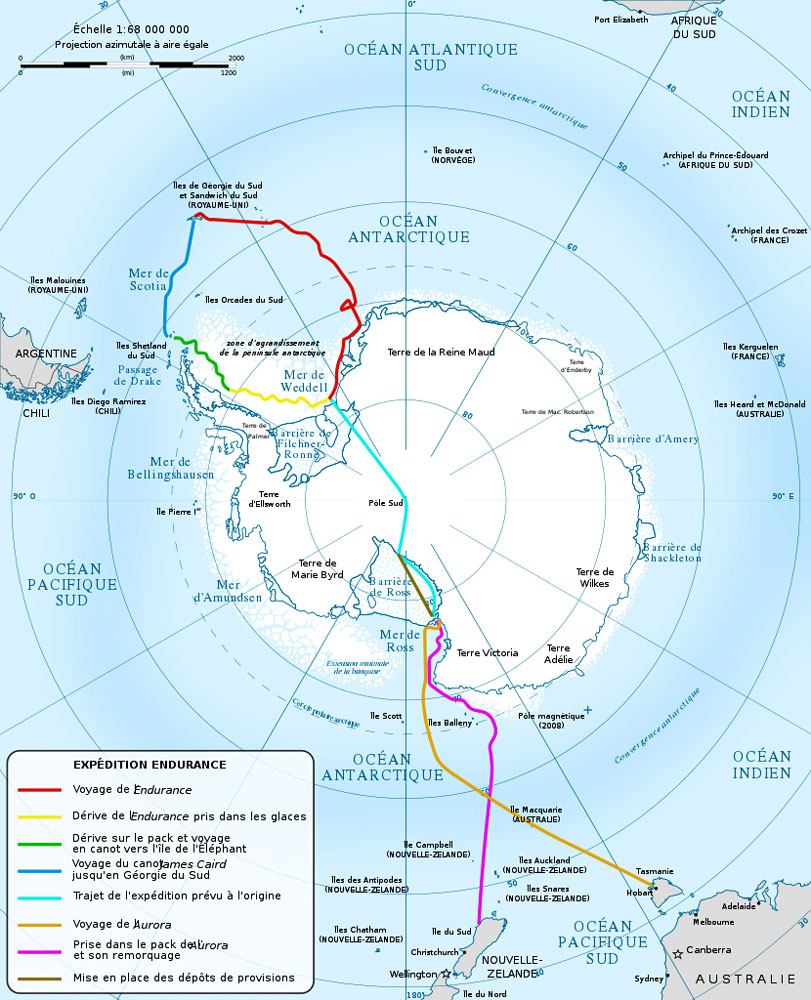
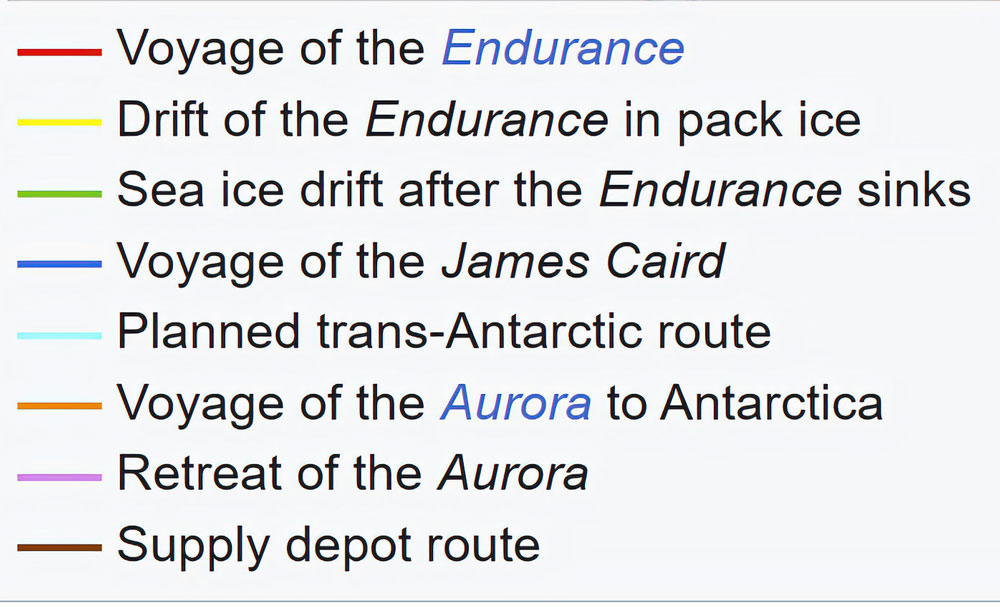
++++++++++++++++++++++++++++++++++++++++++++++++++++++++++++
When we woke up this morning about 6am, we were off of Cape Valentine at Elephant Island. Here's what it looked like.
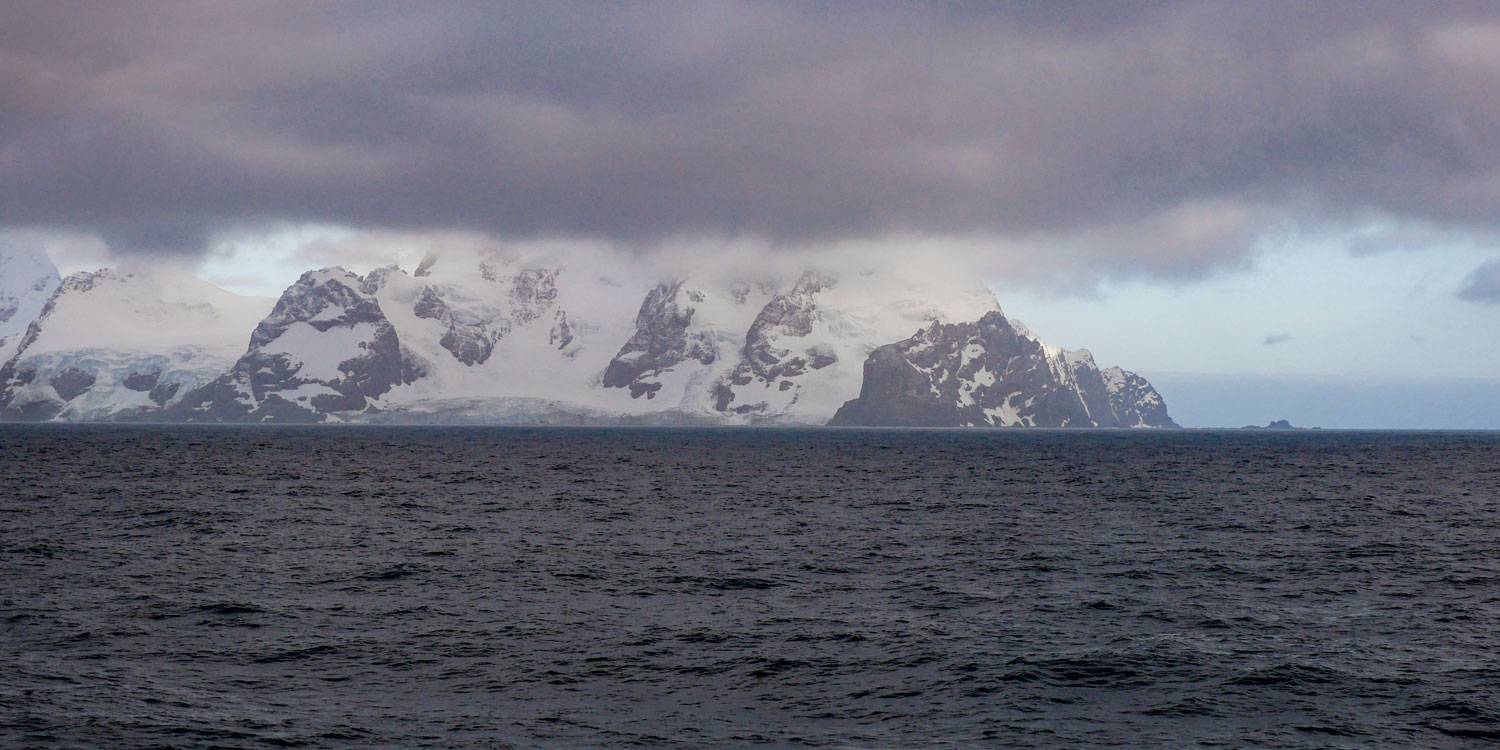
We rounded the cape and headed to Point Wild. Unfortunately, we were unable to take a zodiac tour because the sea was too rough. I was able to get a few pictures from the ship of the spot where Shackleton's crew lived on the island. The pictures are not that clear.
This rock is at the end of Point Wild. The expedition crew were on a spit of land on the other side of this rock. As you can tell, the skies cleared for us between 6am and when we arrived here.
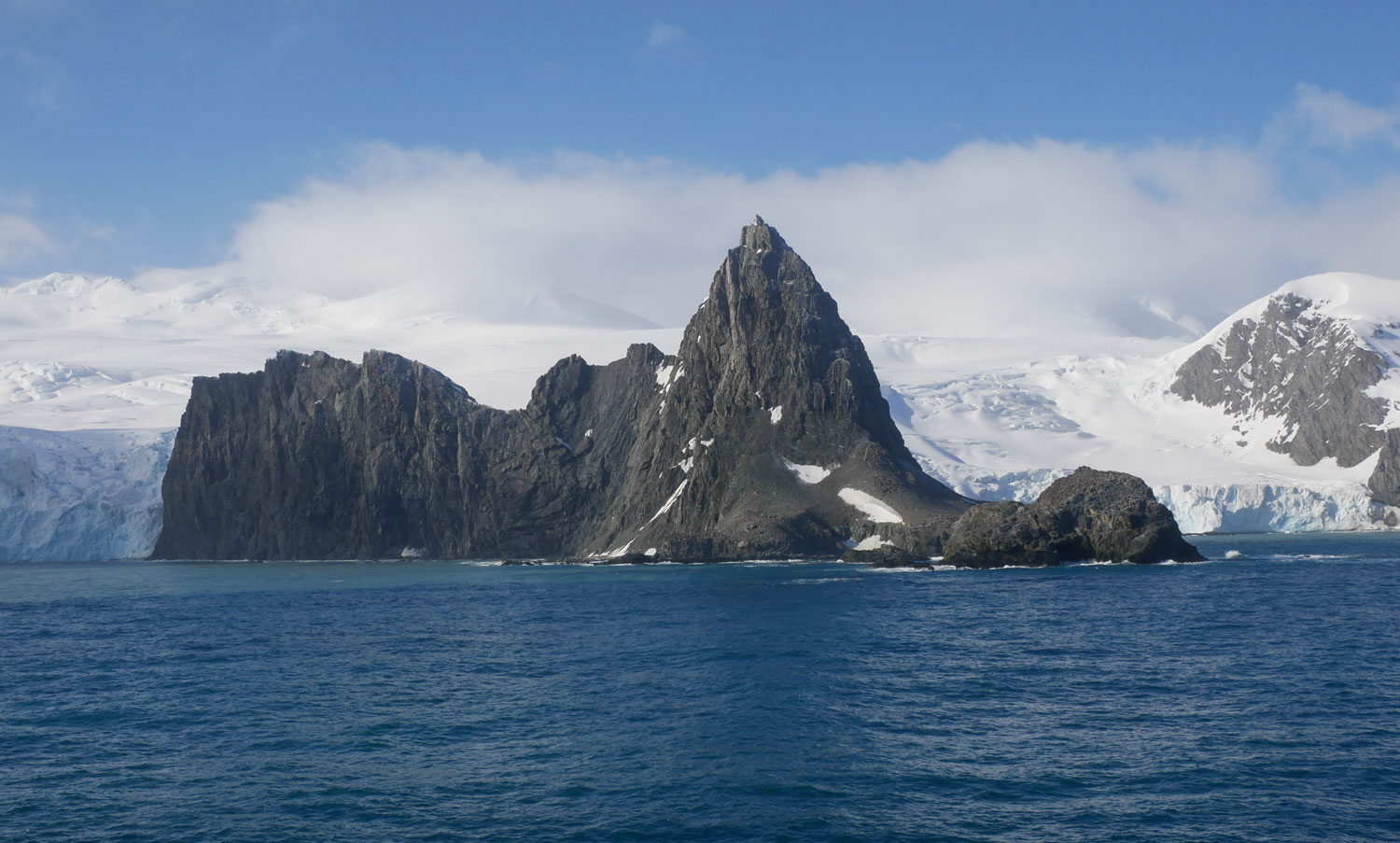
Here's where the crew lived for four and a half months. You can see the monument (at the right) to the Chilean captain in this picture. I'm told that the point has eroded since 1916 so the crew had a bit more ground to live on - but even then, it wasn't a lot of room.
I was shooting at the maximum zoom through a lot of haze so the picture is not as sharp and clear as I'd like. The sunlight was on the opposite side so I'm looking at the shaded side of the point.
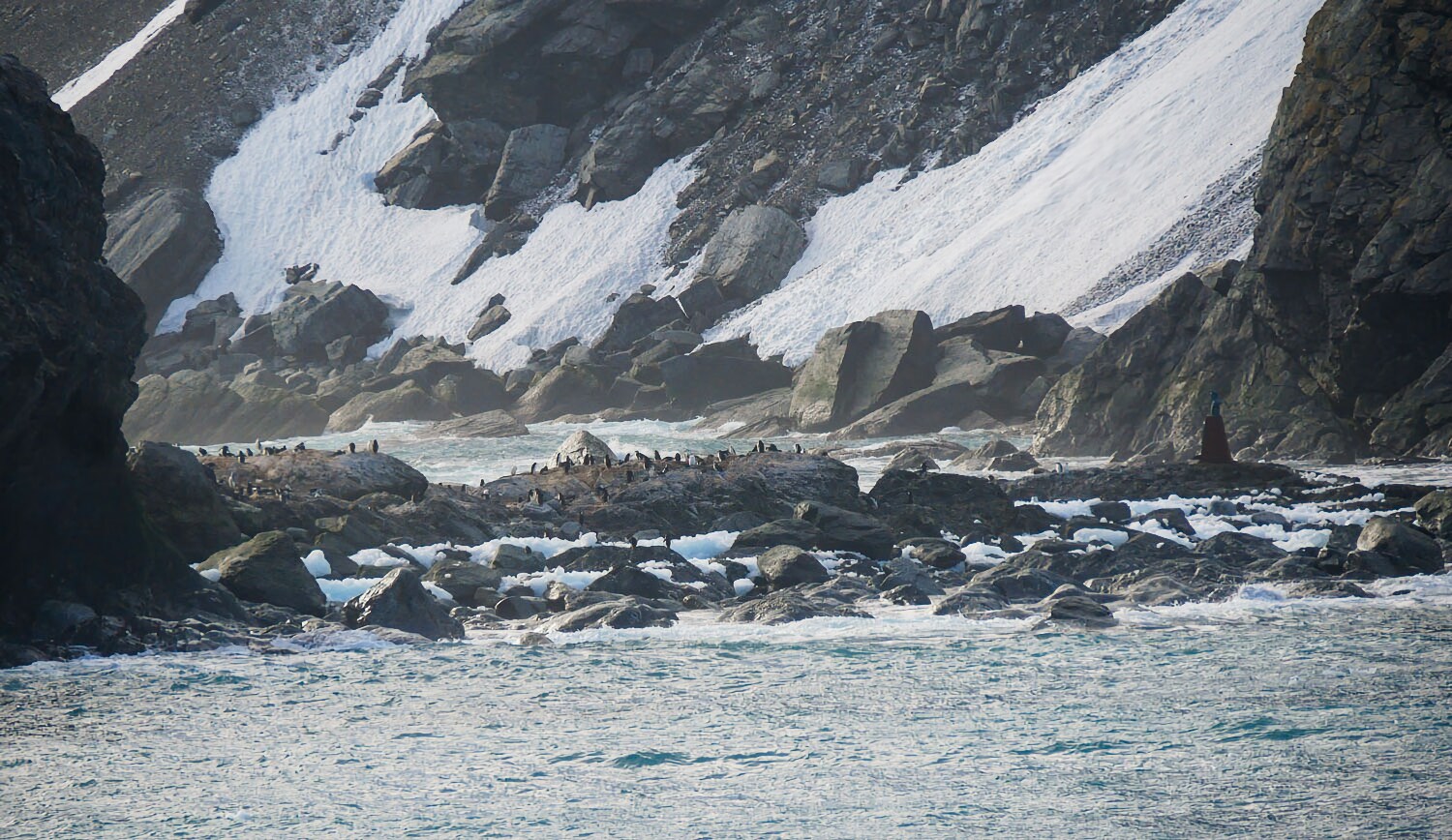
After a while, we pulled out and sailed along the northern coast of Elephant Island before turning towards the Falklands. As we headed towards the Falklands, we passed Seal Islands and I was able to get this picture (at maximum zoom).
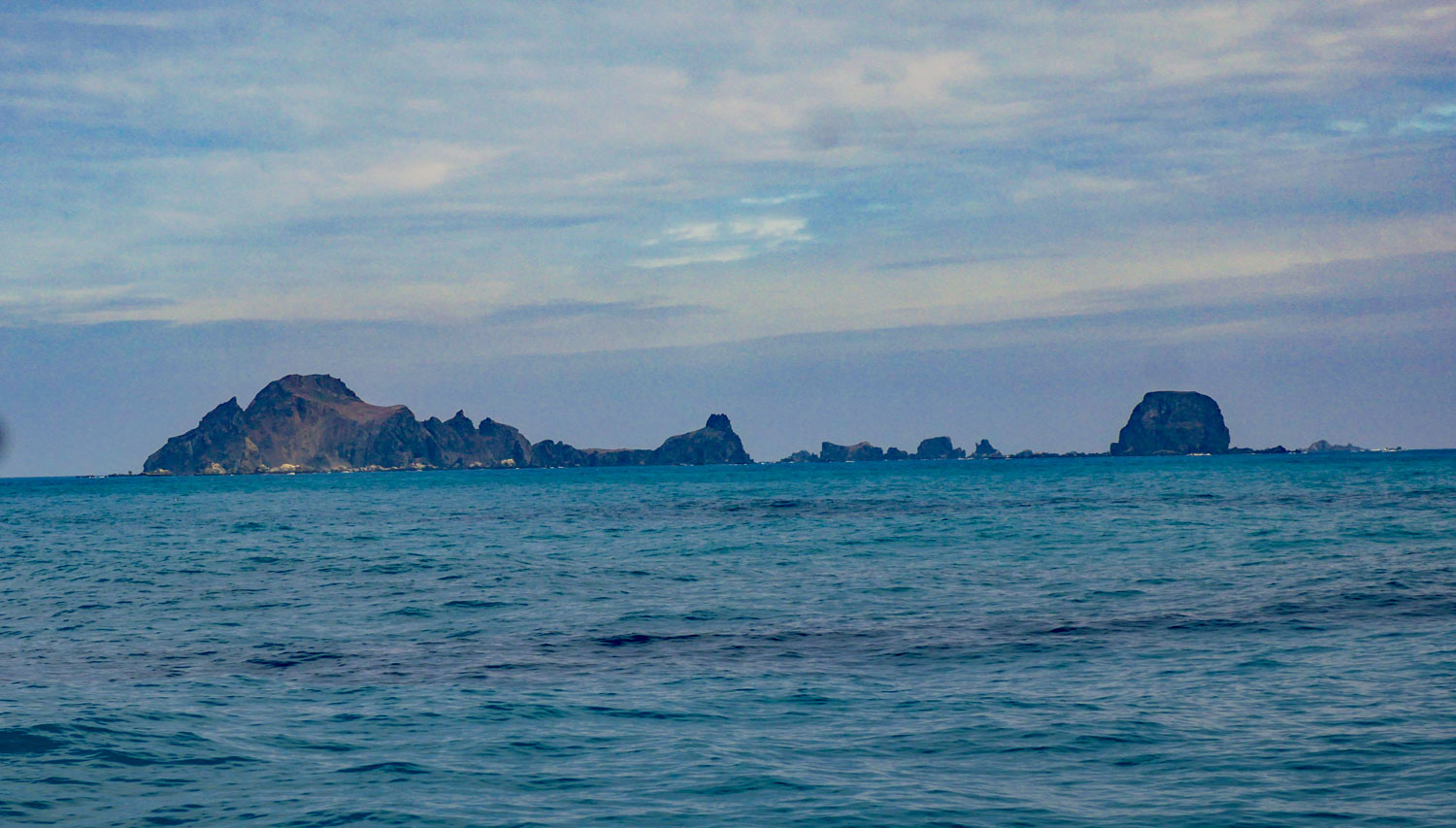
The expedition staff presented two lectures in the morning - we missed the first but attended the one about whales. Very interesting.
So far, the passage through the Drake has been pretty smooth. It is foggy, however, with very little visibility.
In the afternoon Victoria gave a very good lecture on the history of the Falkland Islands, reviewing the claims of the Argentines and the British.
In the evening we had a gala New Year's dinner. Here we are with New Year's hats at dinner. First, Judy and Janet.
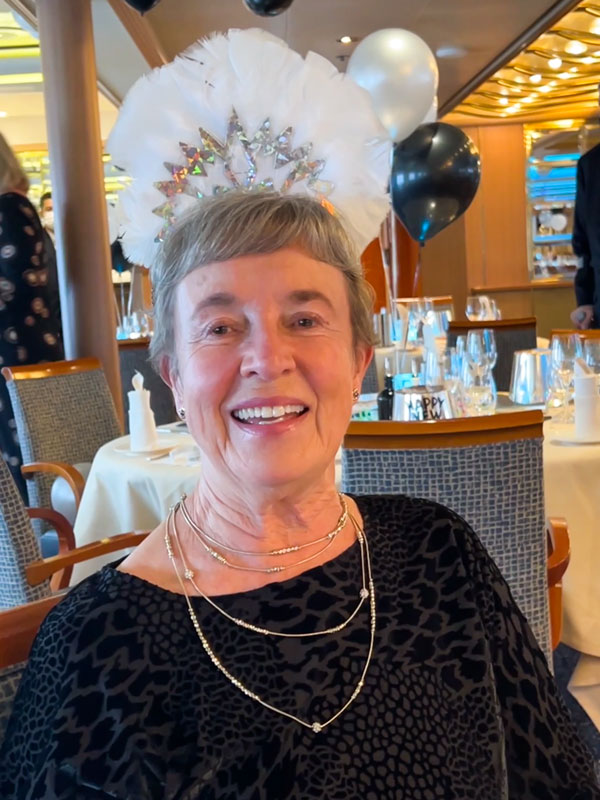
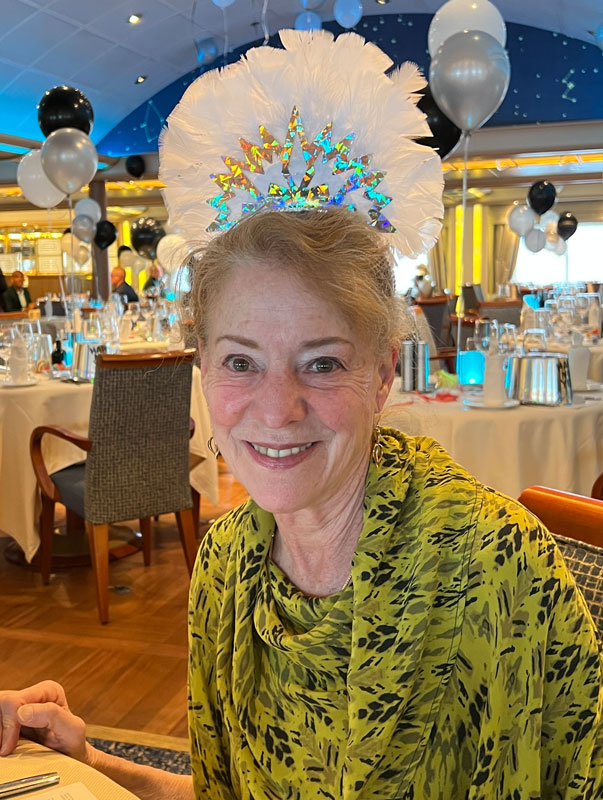
And me.
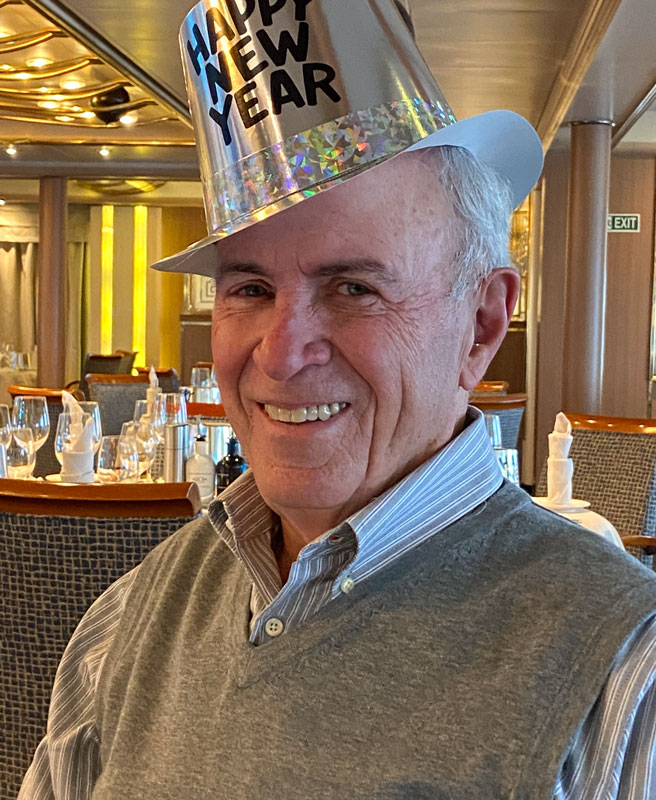
The ship has a Parka Party scheduled for the pool deck, starting at 11pm. We went up to see what they had prepared. Here are a couple of pictures of the preparations on the pool deck. They had decorated the pool bar area, and there was a huge variety of chocolate desserts in addition to hot chocolate and warm mulled wine.
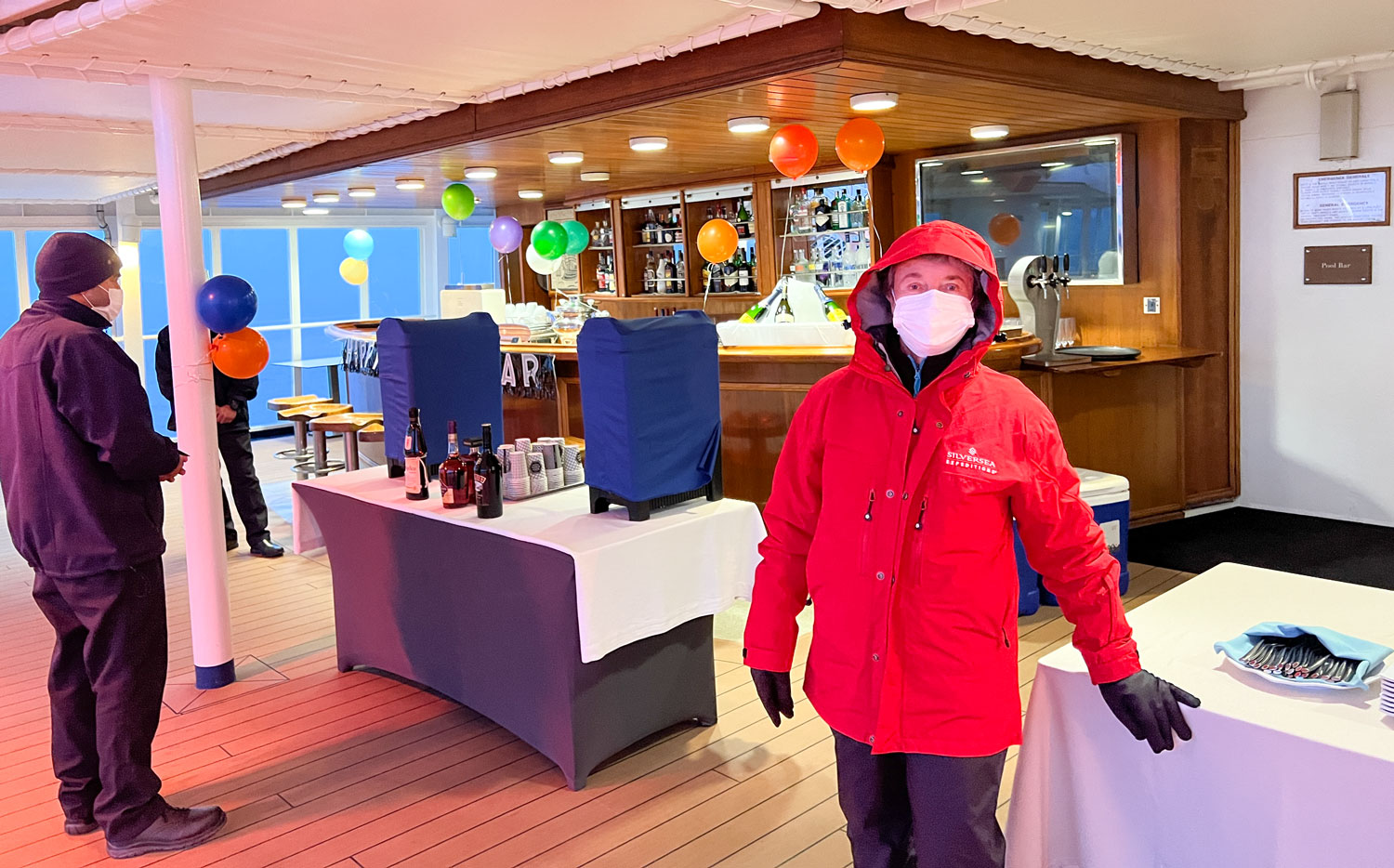
And the sweets.
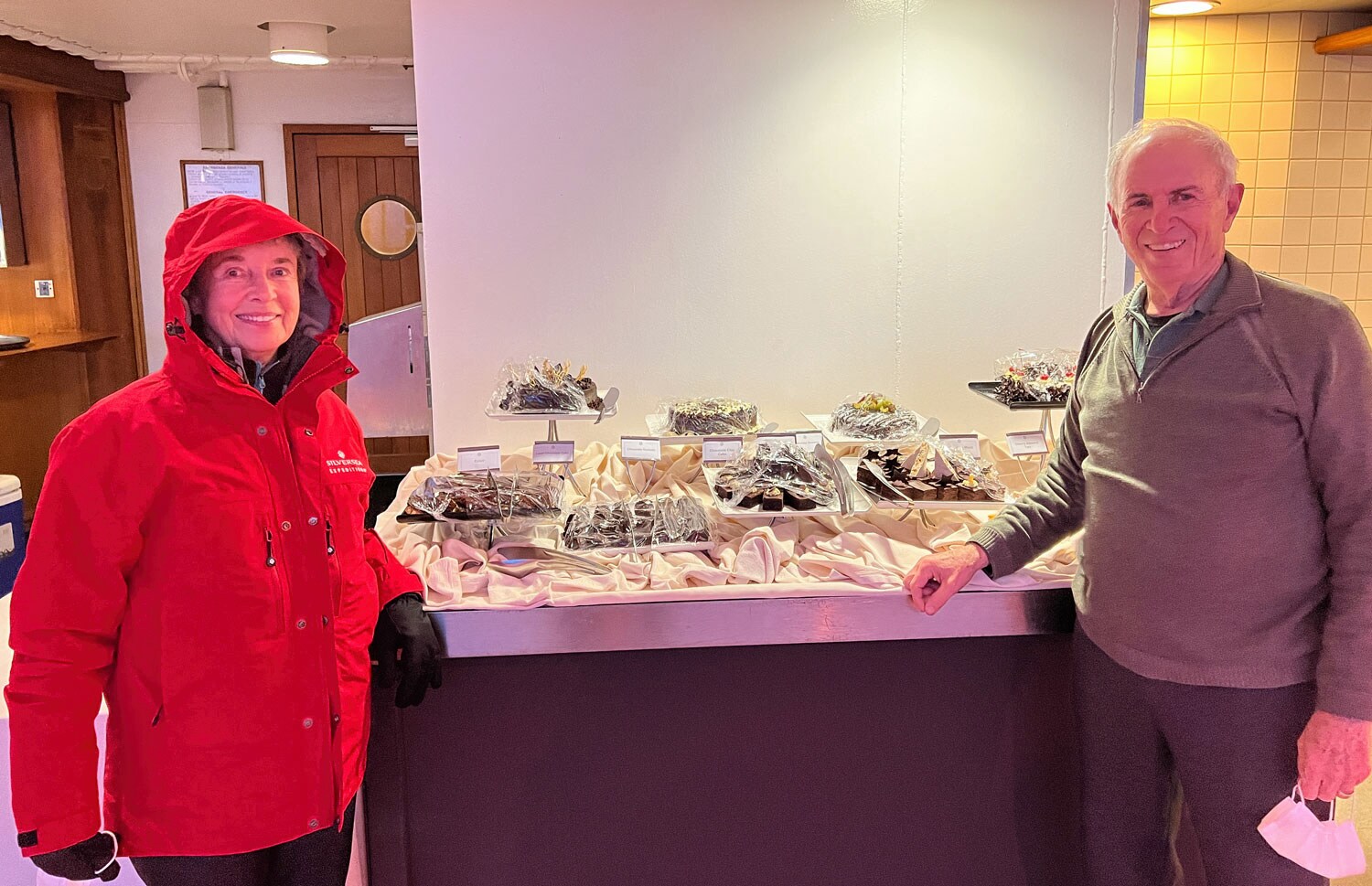
But we were not willing to stay up to see the new year in - we were in bed by 10:30.
++++++++++++++++++++++++++++++++++++++++++++++++++++++++++
1/1/2022 (Saturday, New Year's Day) At Sea in the Drake Passage, heading for the Falkland Islands. Location at 7am, 56˚14.5'S, 57˚6'W. 1˚C, Clear sky with a few clouds, windy and seas running two to three meters.
We woke up late and went to brunch about 10:30. Then back to the cabin for a nap until 2pm when there was a lecture on Climate Change and it's effect on the polar regions.
I tried to take some pictures of birds that were flying close to the ship, but wasn't all that successful. Things are pretty quiet on a sea day.
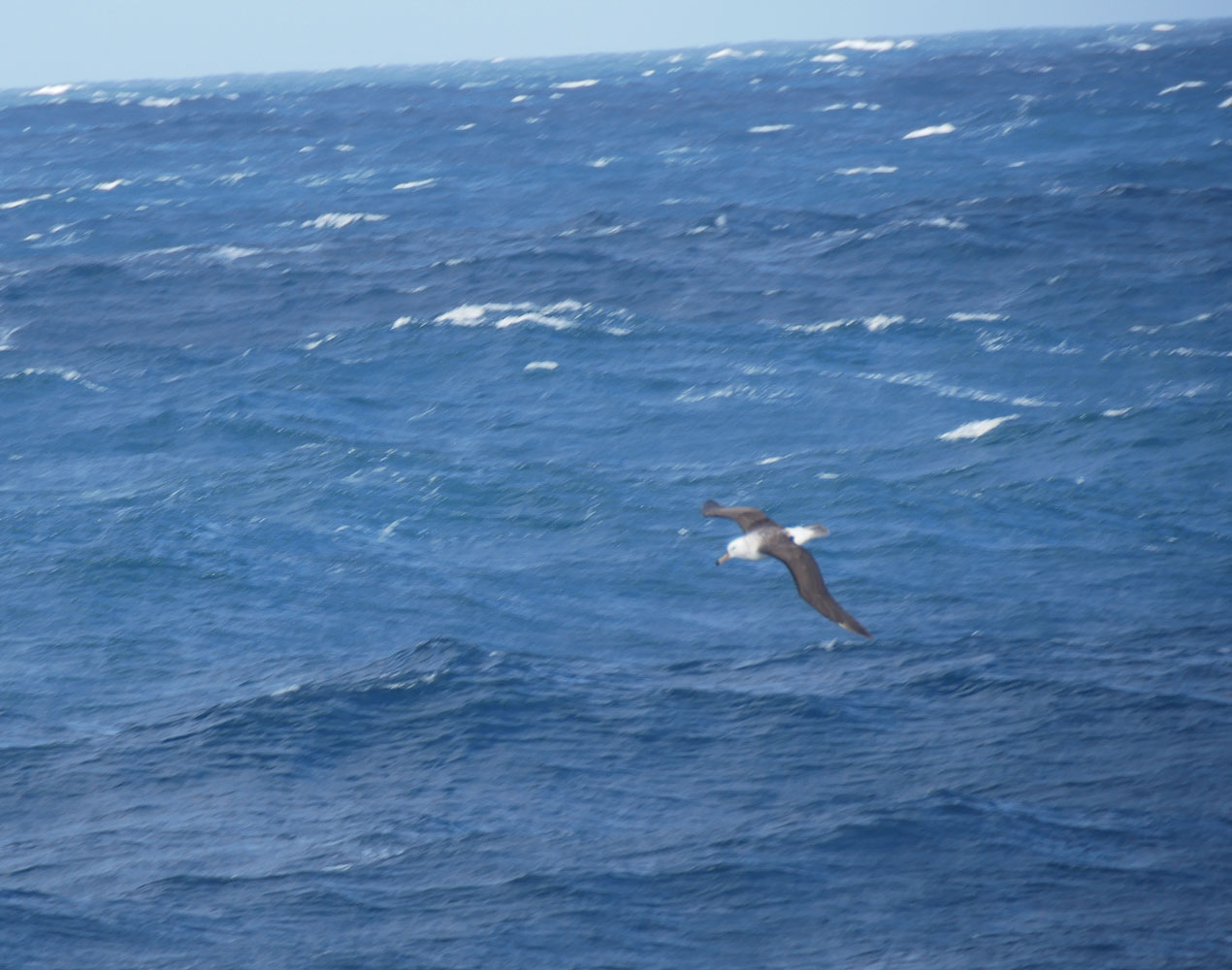
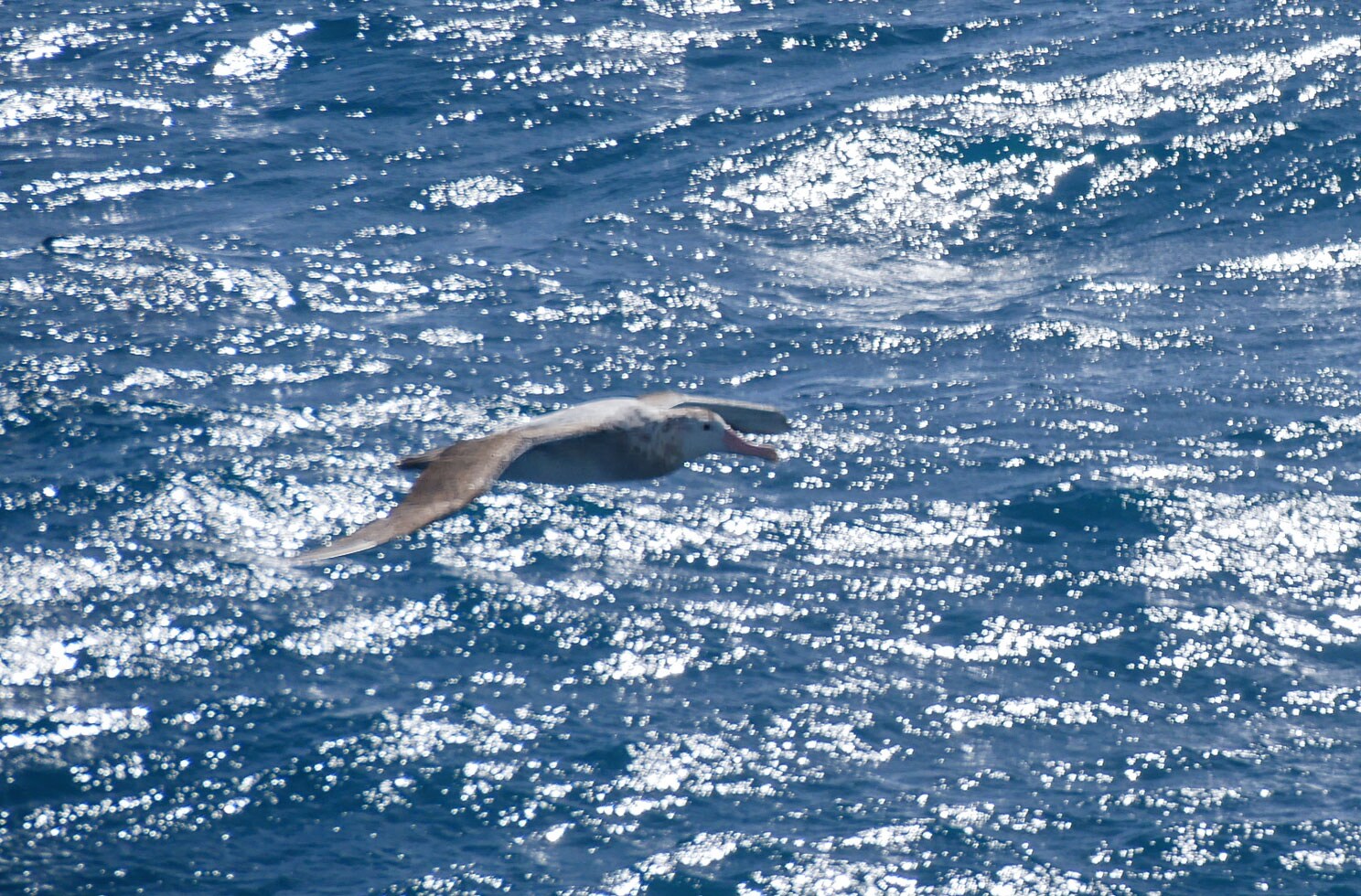
This evening we have a cocktail reception for members of the Venetian Society (repeat customers) at 7pm. Judy and Janet are greeted by the captain.
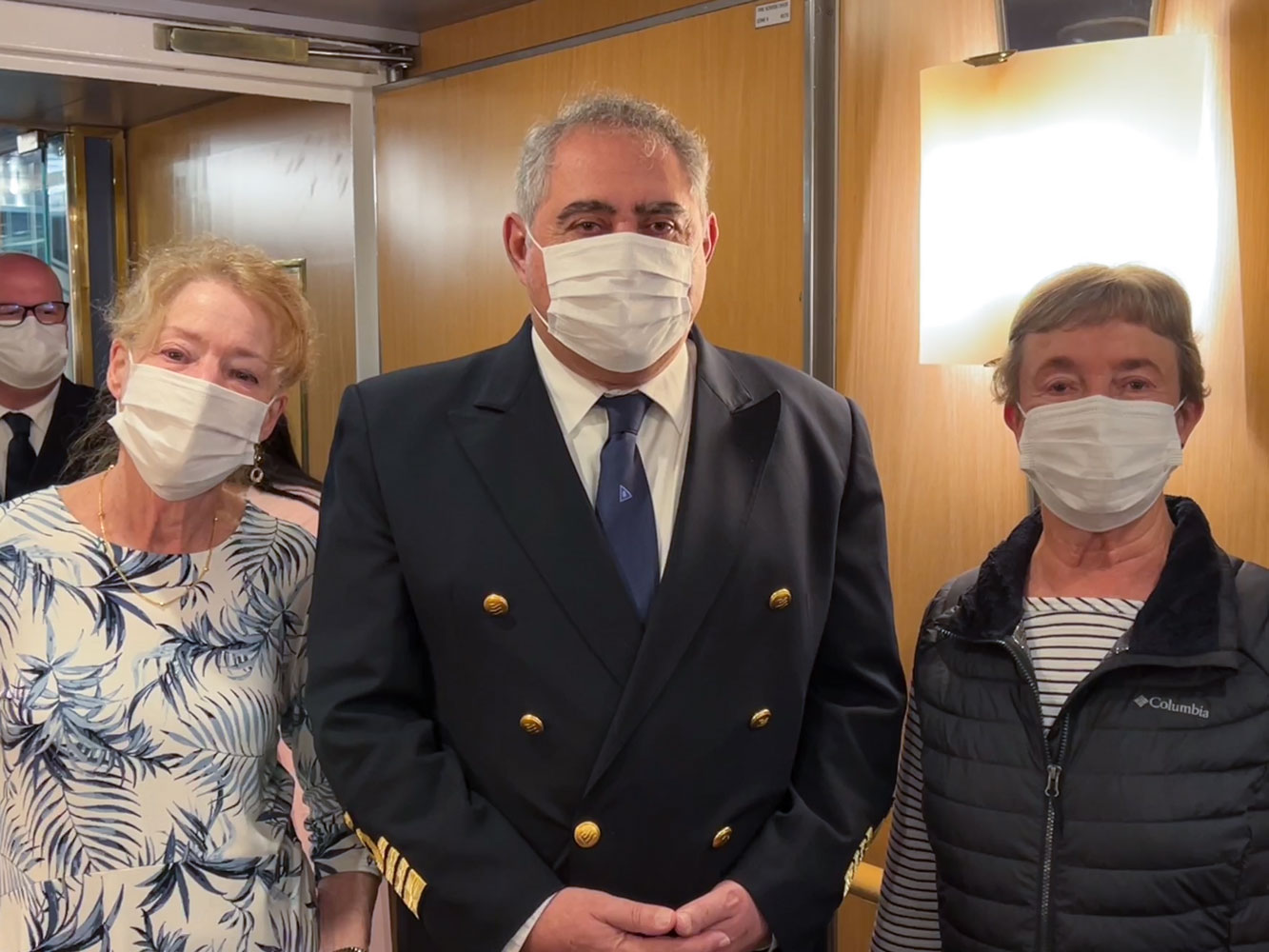
The captain's staff offering a toast to the guests.
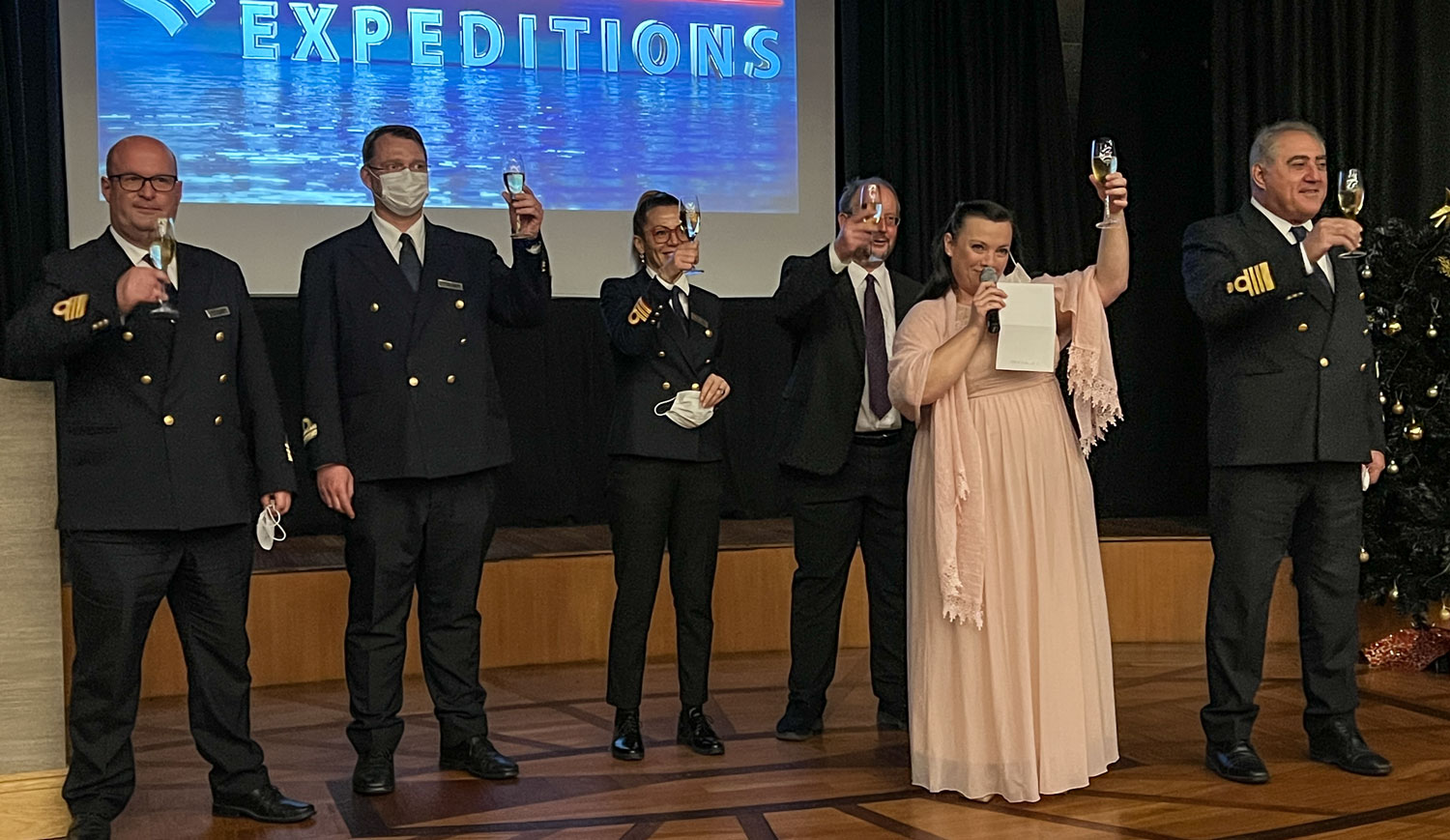
Then it was dinner, and to bed. Tomorrow we arrive at the Falkland Islands.